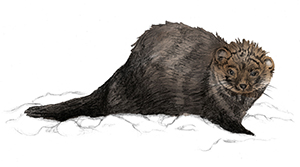Home → Fish & Wildlife → Wildlife → Species Information → Mammals → Fisher
Fisher
Pekania pennanti
On this page:

The fisher is a member of the Mustelid (weasel) family along with several other common Maine furbearers including marten, weasel, mink, and otter. Contrary to their name, fisher do not typically eat fish. Instead, the origins of their name is related to a similar looking animal called “fitch” or “fiche”, meaning a European polecat or pelt thereof.
Habitat
Fisher habitat use is governed by the availability of food, topography, cover, den locations, and weather. Fisher use a wide variety of forest habitats. They avoid open areas (roads, fields, open bogs, and large clear-cuts) with no overhead cover, however edges surrounding these areas are extensively used. Logs, brush piles, trees, and ground burrows are utilized for cover and protection while resting.
Home ranges of fisher in the Northeast vary from 5-10 square miles and males have larger home ranges than females. For many years the fisher was thought to be an animal whose range was restricted to the most heavily wooded spruce-fur regions of Maine. However, recent population expansions have shown the fisher to be much more adaptable than previously believed. Fisher are closely associated with forested areas throughout its range. Therefore, the amount of fisher habitat in Maine has followed the shift from forestland to farmland and back to forestland over the past 200 years. From European settlement until 1880, forestland declined with the expansion of agriculture. From 1880 to 1920, the amount of agricultural land declined rapidly when abandoned agricultural land, predominantly in southern and central Maine, reverted to forest. Since 1925, the rate of increase in forestland has slowed. By 1950, approximately 80% of Maine was forested. Since 1971, forestland has remained stable at about 90% of the land area. Abandoned farmland with its greater diversity of food, may be more suitable for fisher than the original forests.
Diet
Fisher are carnivores, consuming snowshoe hare, porcupine, small rodents, upland birds, and carrion of deer, moose, and beaver. Fisher will also eat foods that are seasonally available, such as fruits and nuts. Contrary to their name, fisher do not typically eat fish. Fisher are agile and the most successful predator of porcupines. A recent study has also documented that fisher are an important predator of Canada lynx in northern Maine. Between 1999-2011, the Department captured and equipped 85 lynx with radio-collars and investigated mortalities when they occurred. Predation was the leading cause of mortality, with at least 14 of the 65 lynx mortalities attributed to fisher. Learn more about Canada Lynx in Maine.
Distinctive Characteristics
Fishers have long bodies with short legs, rounded ears, and a thick dark brown coat with a bushy tail. Fishers also have five toes with retractable claws making them excellent climbers and hunters. Generally, male fisher are about 20% longer than females and weight nearly twice as much. For both males and females, adults (greater than 1 year of age) are larger than juveniles (less than one year of age) when captured in the fall. The average male fisher is 10 pounds, but some exceptionally large individuals may exceed 20 pounds. The fur of female fisher is usually darker and silkier than the fur of males. In older males, the fur may be coarse and grizzled.
Nocturnal/Diurnal
Fisher tend to be more nocturnal and active during dawn or dusk in the summer and may be more active during the day during the winter months. They tend to be shy and elusive animals and are rarely seen.
Seasonal Changes
Fisher are active year-round but remain in their dens during severe winter weather.
Reproduction & Family Structure
Female fisher reach sexual maturity and breed at one year of age. Males are sexually mature at one year of age, but because females are induced ovulators (the egg not being released until the stimulation of breeding) and because the baculum of young males is not fully grown they may not be effective in inducing ovulation. Fisher breed in March or April. The fertilized egg grows to approximately 1 mm in diameter (called a blastocyst) and then ceases development. This cessation of development (delayed implantation) lasts from 10-11 months. If the female is in good condition, growth resumes with implantation in the winter and 1-5 kits are born in late March or April, typically in the cavity of a large tree.
Survival & Threats
Habitat loss and degradation of forests are threats to fisher. Large clear-cuts can reduce fisher habitat for a small period of time, but regenerating forests are optimal for their primary prey, the snowshoe hare. The fisher population may also be limited by parasites and diseases, but more research is needed to identify these further. Additionally, trapper harvest and vehicle collisions account for mortality across the state.
Management & Conservation
MDIFW regulates and manages the trapping of fisher. All fisher that are trapped must be registered and tagged, along with submissions of a tooth sample of determine age and sex of the animals. Biologists monitor the harvest data to ensure that trapping levels are sustainable.
Recently, the Department has been working with the University of Maine to develop a monitoring protocol to track population trends of marten and fisher in Maine. Baited, motion-activated cameras are effective at detecting meso-carnivores that can be difficult to monitor using more traditional methods like snow track surveys. We anticipate camera surveys to be an efficient tool to monitor multiple species in the future.
Living with Wildlife
How to Prevent or Resolve Conflicts with Fisher
Always start with the standard steps to avoiding conflicts and make sure you have eliminated access to food, shelter, and water.
Learn more about how to prevent or resolve conflicts with fisher